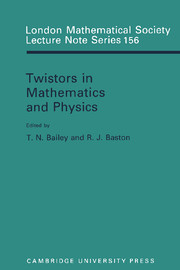Book contents
- Frontmatter
- Preface
- Contents
- 1 Twistor Theory After 25 Years—its Physical Status and Prospects
- 2 Between Integral Geometry and Twistors
- 3 Generalized Conformal Structures
- 4 Riemannian Twistor Spaces and Holonomy Groups
- 5 Twistors, Ambitwistors, and Conformal Gravity
- 6 The Penrose Transform
- 7 Notation for the Penrose Transform
- 8 The Twistor Transform
- 9 Invariant Operators
- 10 Penrose's Quasi-local Mass
- 11 The Sparling 3-form, Ashtekar Variables and Quasi-local Mass
- 12 Twistors and Strings
- 13 Integrable Systems in Twistor Theory
- 14 Twistor Characterization of Stationary Axisymmetric Solutions of Einstein's Equations
- 15 A Two-surface Encoding of Radiative Space-times
- 16 Twistors, Massless Fields and the Penrose Transform
- 17 Twistor Diagrams and Feynman Diagrams
- 18 Cohomology and Twistor Diagrams
- Authors' addresses
17 - Twistor Diagrams and Feynman Diagrams
Published online by Cambridge University Press: 05 May 2013
- Frontmatter
- Preface
- Contents
- 1 Twistor Theory After 25 Years—its Physical Status and Prospects
- 2 Between Integral Geometry and Twistors
- 3 Generalized Conformal Structures
- 4 Riemannian Twistor Spaces and Holonomy Groups
- 5 Twistors, Ambitwistors, and Conformal Gravity
- 6 The Penrose Transform
- 7 Notation for the Penrose Transform
- 8 The Twistor Transform
- 9 Invariant Operators
- 10 Penrose's Quasi-local Mass
- 11 The Sparling 3-form, Ashtekar Variables and Quasi-local Mass
- 12 Twistors and Strings
- 13 Integrable Systems in Twistor Theory
- 14 Twistor Characterization of Stationary Axisymmetric Solutions of Einstein's Equations
- 15 A Two-surface Encoding of Radiative Space-times
- 16 Twistors, Massless Fields and the Penrose Transform
- 17 Twistor Diagrams and Feynman Diagrams
- 18 Cohomology and Twistor Diagrams
- Authors' addresses
Summary
Introduction
The purpose of twistor diagram theory remains as first envisaged by Penrose [18]. It is to enable us to identify a new fundamental structure in twistor geometry for the description of quantum field theory (QFT) in flat space-time. This new structure should eliminate the unsatisfactory features of standard QFT, particularly the divergences and renormalisation schemes. The further hope is that a twistor-geometric formalism could explain the spectrum of observed physical particles and provide the starting point for the unification of QFT with gravity.
The essential character of twistor diagram theory also remains Penrose's. The idea is that twistor diagrams themselves are to play the role in a twistorial QFT of Feynman diagrams in conventional QFT. That is, they are to supply a perturbation expansion calculus for physical scattering amplitudes. The guiding principle is that in analogy to Feynman diagrams they should be defined by the systematic combination of very simple elements. These elements and the rules for combining them should be expressible in a form which is essentially combinatorial (hence appropriately represented by a diagrammatic formalism). The elements and the rules should also be manifestly finite. In the original ‘classical’ theory they were also to be manifestly conformally invariant. As such the theory was at first necessarily restricted to the description of massless fields, and indeed was envisaged originally as to be applied to massless quantum electrodynamics (QED).
Information
- Type
- Chapter
- Information
- Twistors in Mathematics and Physics , pp. 339 - 366Publisher: Cambridge University PressPrint publication year: 1990
Accessibility standard: Unknown
Why this information is here
This section outlines the accessibility features of this content - including support for screen readers, full keyboard navigation and high-contrast display options. This may not be relevant for you.Accessibility Information
- 6
- Cited by
